Evaluation of Subsidy Programmes
This research group develops the scientific foundations for causal impact analysis of policy interventions within the European Union, with a particular focus on place-based policies. Despite significant public spending on such programmes in many developed economies, there is limited evidence on their effectiveness and efficiency.
Our approach integrates three key dimensions: first, the systematic use of administrative funding data and legislative documents; second, the application of advanced methods in policy impact evaluation; and third, the exchange of knowledge among researchers, policymakers, public administration, and civil society. Without this integration, research risks becoming either overly abstract or disconnected from the institutional and legal realities of policy implementation. By combining these elements, we create robust research designs grounded in real data and legal frameworks.
This approach allows us to generate evidence-based insights that contribute to better informed decision-making—not only in politics but also within civil society. The findings of our work have contributed to the revision and improvement of existing subsidy programmes. The research group is closely embedded in the activities of the Centre for Evidence-based Policy Advice (CEP), ensuring both scientific rigor and practical relevance. In doing so, we embody the leitmotif of the Leibniz Association: theoria cum praxi.
Research Cluster
Economic Dynamics and StabilityYour contact

- Department Centre for Evidence-based Policy Advice
EXTERNAL FUNDING
09.2019 ‐ 09.2022
Establishing Evidence-based Evaluation Methods for Subsidy Programmes in Germany (EVA-KULT)
The project aims at expanding the Centre for Evidence-based Policy Advice at the Halle Institute for Economic Research (IWH-CEP).
01.2018 ‐ 12.2020
Networked growth - Innovative Saxony-Anhalt through digital business models (Competence Center 4.0)
01.2017 ‐ 12.2018
Political Participation in Eastern Germany
12.2015 ‐ 11.2018
Socio-economic Effects of Research on Innovative Approaches for POC Diagnostics
Part of the EXASENS project. Coordinated by the Leibniz Institute of Photonic Technology (IPHT) in Jena, nine Leibniz institutes are working together on researching point-of-care (POC) technology for the prediction and diagnosis of chronic inflammatory respiratory diseases. See press release.
02.2017 ‐ 02.2018
The Importance of Non-University Research Institutions for the Development of Firms and Regions (Be_For_Reg-Projekt)
01.2015 ‐ 12.2016
Evaluation of the "Joint Task 'Improving the Regional Economic Structure'" in the Federal State of Saxony-Anhalt
Refereed Publications

Drivers of the Spatial Emergence and Clustering of the Photovoltaic Industry in Germany
in: Zeitschrift für Wirtschaftsgeographie, No. 3, 2015
Abstract
The drivers of the spatial emergence and clustering of the photovoltaic industry in Germany. Following the relatedness literature, we explore to what extent related industries influenced the regional emergence of the photovoltaic (PV) industry. In addition, we shed light on factors explaining selective processes of clustering. We particularly argue that generic resources and resources of related activities have been crucial for the regional concentration in early phases of the industry life cycle. With increasing maturity, industry-specific resources became more important. Based on a unique dataset containing population dynamics of the German PV industry, the hypotheses are tested empirically. Our results partially confirm the assumed beneficial effects of related industries for the emergence of the PV industry. Moreover, we observe changes in the relative importance of factors supporting regional concentration, with industry-specific resources becoming dominant as the industry matures.
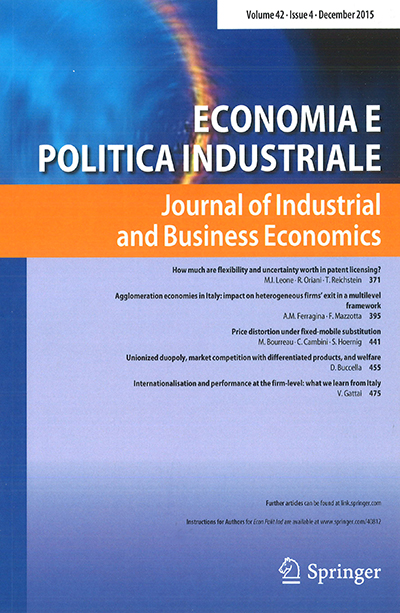
Determinants of Knowledge Exchange Between Foreign and Domestic Enterprises in European Post-transition Economies
in: Journal Economia e Politica Industriale (Journal of Industrial and Business Economics), No. 4, 2014
Abstract
The aim of this paper is to contribute to the literature on internationalised research and development by investigating determinants of knowledge and technology transfer between foreign subsidiaries and the local economy in European post-transition economies. This inquiry leads to a better understanding of determinants that influence this knowledge and technology exchange. Applying a logit model, we find that, in particular, the foreign subsidiary’s corporate governance structure, its embeddedness in the multinational enterprise’s internal knowledge base, its own technological capacity, the growth of the regional knowledge stock and the regional sectoral diversification are all positively associated with the transfer of knowledge. Subsidiaries’ investment motives and the relative weight of the sector of investment in the region’s economy appear to be of less importance. The analysis focuses on European post-transition economies, using the example of five selected Central Eastern European countries and East Germany. We exploit a unique dataset, the IWH FDI Micro database, which contains information on one thousand two hundred forty-five foreign subsidiaries in this region.
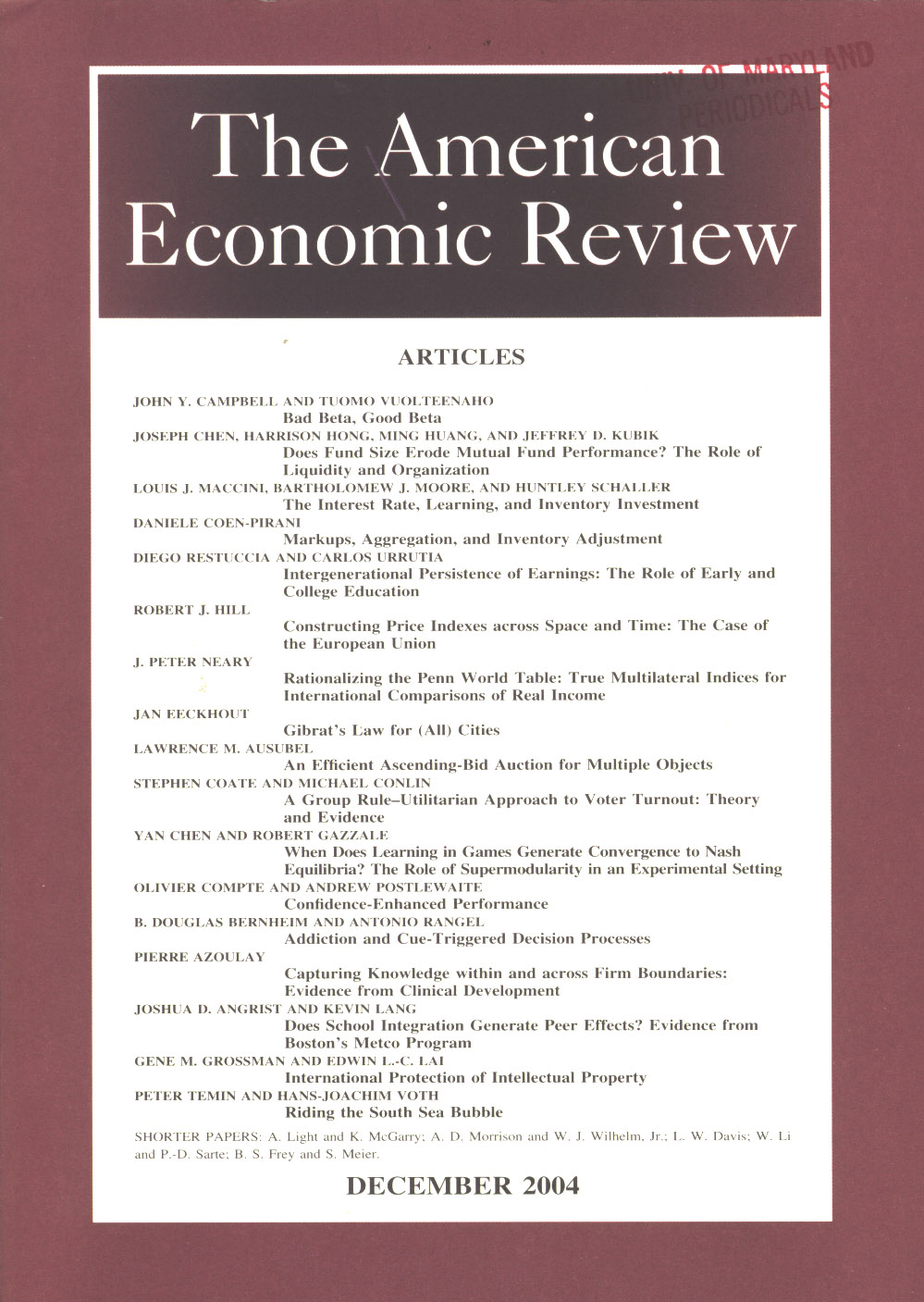
A Community College Instructor Like Me: Race and Ethnicity Interactions in the Classroom
in: American Economic Review, No. 8, 2014
Abstract
Administrative data from a large and diverse community college are used to examine if underrepresented minority students benefit from taking courses with underrepresented minority instructors. To identify racial interactions we estimate models that include both student and classroom fixed effects and focus on students with limited choice in courses. We find that the performance gap in terms of class dropout rates and grade performance between white and underrepresented minority students falls by 20 to 50 percent when taught by an underrepresented minority instructor. We also find these interactions affect longer term outcomes such as subsequent course selection, retention, and degree completion.
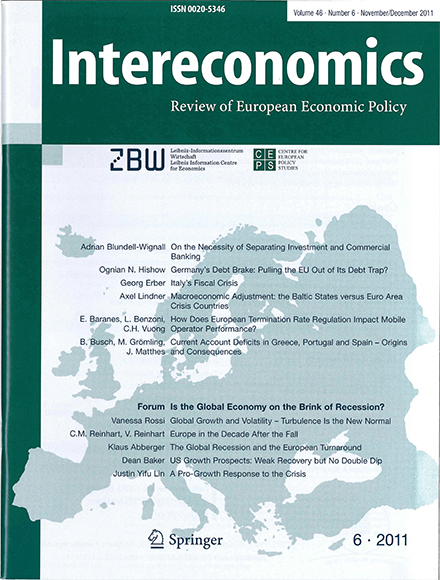
The Skills Balance in Germany’s Import Intensity of Exports: An Input-Output Analysis
in: Intereconomics, No. 2, 2014
Abstract
In the decade prior to the economic and financial crisis, Germany’s net exports increased in absolute terms as well as relative to the growing level of import intensity of domestically produced export goods and services. This article analyses the direct and indirect employment effects induced both by exports as well as by of the import intensity of the production process of export goods and services on the skills used. It shows that Germany’s export surpluses led to positive net employment effects. Although the volume of imports of intermediate goods increased and was augmented by the rise in exports, it could not undermine the overall positive employment effect.
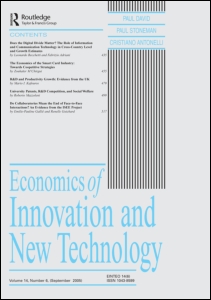
R&D Cooperation for Non-technological Innovations
in: Economics of Innovation and New Technology, No. 7, 2014
Abstract
Past research on the impact of R&D cooperation on firm innovation performance has almost solely focused on technological innovations. This paper investigates the impact of R&D cooperation on non-technological innovation performance of firms. In doing so, seven different cooperation partner types are distinguished. Survey data from German firms are used for the econometric analysis. It is shown that R&D cooperation increases the probability of a firm to introduce non-technological innovations. R&D cooperation with suppliers, consultants, other firms within the same firm group and universities has a significant positive impact on organizational and marketing innovation performance. Cooperation with governmental research institutes and competitors has no significant effect. R&D cooperation with customers has a significant impact on a firm's organizational innovation performance, but not on marketing innovation performance.
Working Papers
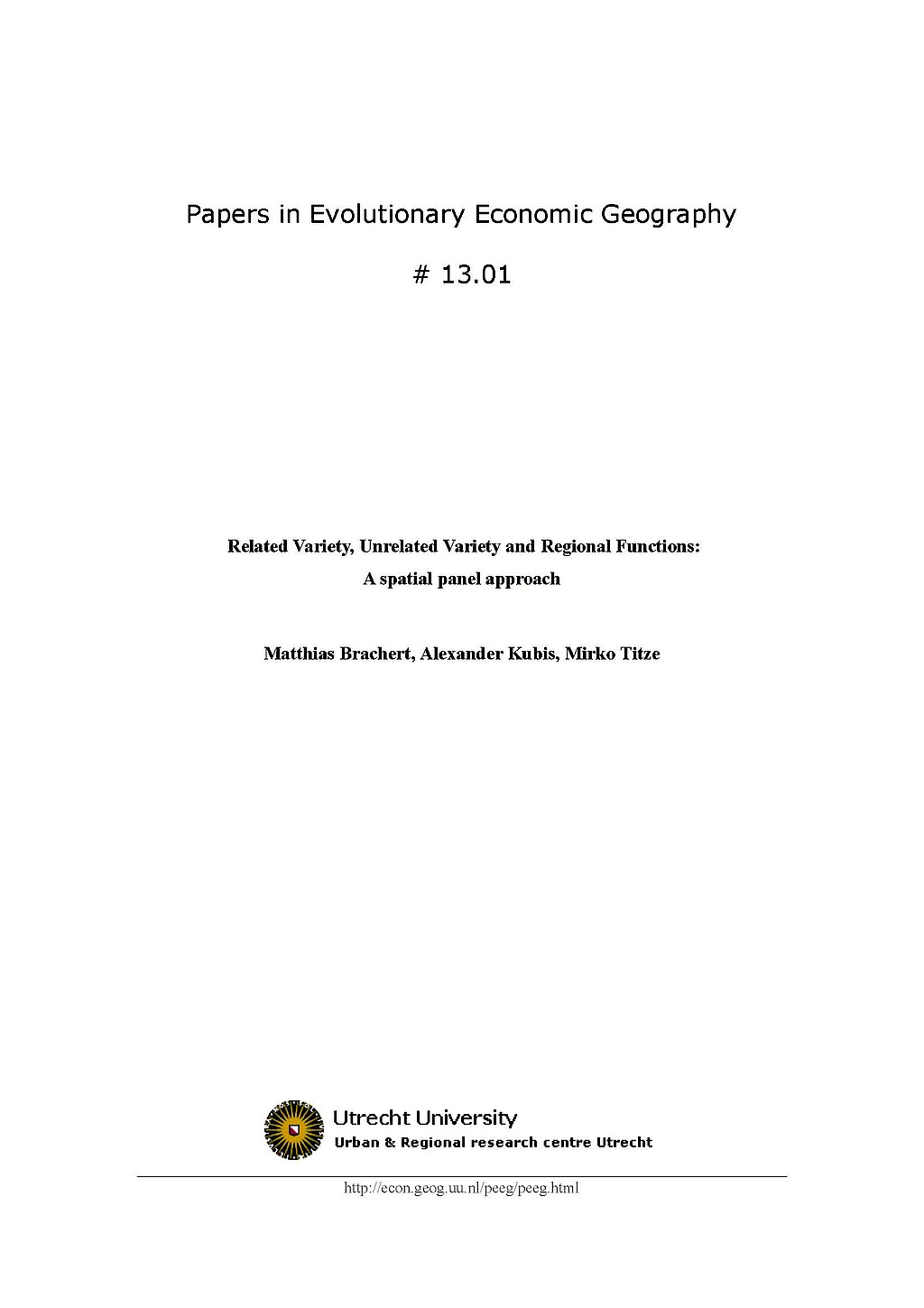
Related Variety, Unrelated Variety and Regional Functions: A spatial panel approach
in: Papers in Evolutionary Economic Geography, 2013
Abstract
The paper presents estimates for the impact of related variety, unrelated variety and the functions a region performs in the production process on regional employment growth in Germany. We argue that regions benefit from the existence of related activities that facilitate economic development. Thereby the sole reliance of the related and unrelated variety concept on standard industrial classifications (SIC) remains debatable. We offer estimations for establishing that conceptual progress can be made when the focus of analysis goes beyond solely considering industries. We develop an industry-function based approach of related and unrelated variety and test our hypothesis by the help of spatial panel approach. Our findings suggest that related variety as same as unrelated variety facilitate regional employment growth in Germany. However, the drivers behind these effects do differ. While the positive effect of related variety is driven by high degrees of relatedness in the regional “R&D” and “White-Collar”-functions, the effects of unrelated variety are spurred by “Blue Collar”-functions in this period.













